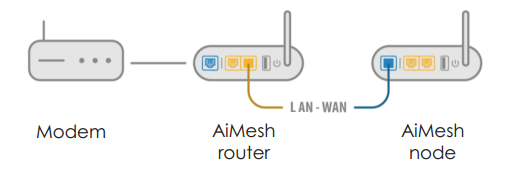DrFrankenscript
Occasional Visitor
Hi folks,
This is a very basic question that I'm a bit embarrassed to ask. I've got three RT-AX92U routers to cover my house. It's a bit overkill, but think of my house as being "long" in one axis, with a main floor, a second floor over that, and a full basement beneath, with plenty of devices in basement and second floor needing good signal. The main router is centrally located in my office which is on the main floor, and the two other routers (currently set into access point mode) are on the main floor at the extreme ends of the home. The two units being used as access points are connected via cat6 ethernet to the main router. Coverage is perfect and speeds are great. The only problem I have is an issue with certain IoT devices as described here.
That all said, I'd like to set up the system as an AiMesh arrangement for centralized management particularly of my guest networks (one of which is for 2.4 GHz IoT devices exclusively...). However, I may have a fundamental misunderstanding of how that works. On my main router when I go into the AiMesh settings and attempt to add nodes, it doesn't recognize the other two routers (wired in access points) as being available. And, the instructions talk about having the nodes close to each other as though they are going to communicate wirelessly rather than via ethernet. Is AiMesh something done only when connecting nodes via wifi? If so, then I don't want that an the right solution is to keep them as simple access points I suppose, though that means any changes to wireless networks have to be made manually to each of the three devices. Or, maybe I'm missing something fundamental.
Can I get the centralized management benefit when my two satellite routers are connected via ethernet?
This is a very basic question that I'm a bit embarrassed to ask. I've got three RT-AX92U routers to cover my house. It's a bit overkill, but think of my house as being "long" in one axis, with a main floor, a second floor over that, and a full basement beneath, with plenty of devices in basement and second floor needing good signal. The main router is centrally located in my office which is on the main floor, and the two other routers (currently set into access point mode) are on the main floor at the extreme ends of the home. The two units being used as access points are connected via cat6 ethernet to the main router. Coverage is perfect and speeds are great. The only problem I have is an issue with certain IoT devices as described here.
That all said, I'd like to set up the system as an AiMesh arrangement for centralized management particularly of my guest networks (one of which is for 2.4 GHz IoT devices exclusively...). However, I may have a fundamental misunderstanding of how that works. On my main router when I go into the AiMesh settings and attempt to add nodes, it doesn't recognize the other two routers (wired in access points) as being available. And, the instructions talk about having the nodes close to each other as though they are going to communicate wirelessly rather than via ethernet. Is AiMesh something done only when connecting nodes via wifi? If so, then I don't want that an the right solution is to keep them as simple access points I suppose, though that means any changes to wireless networks have to be made manually to each of the three devices. Or, maybe I'm missing something fundamental.
Can I get the centralized management benefit when my two satellite routers are connected via ethernet?

